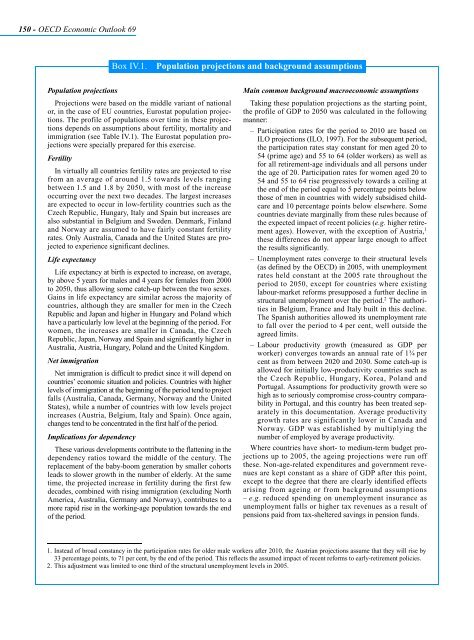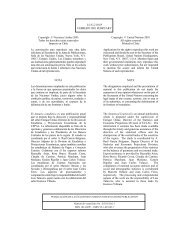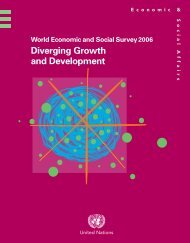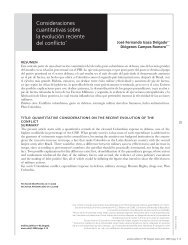OECD Economic Outlook 69 - Biblioteca Hegoa
OECD Economic Outlook 69 - Biblioteca Hegoa
OECD Economic Outlook 69 - Biblioteca Hegoa
Create successful ePaper yourself
Turn your PDF publications into a flip-book with our unique Google optimized e-Paper software.
150 - <strong>OECD</strong> <strong>Economic</strong> <strong>Outlook</strong> <strong>69</strong><br />
Population projections<br />
Box IV.1. Population projections and background assumptions<br />
Projections were based on the middle variant of national<br />
or, in the case of EU countries, Eurostat population projections.<br />
The profile of populations over time in these projections<br />
depends on assumptions about fertility, mortality and<br />
immigration (see Table IV.1). The Eurostat population projections<br />
were specially prepared for this exercise.<br />
Fertility<br />
In virtually all countries fertility rates are projected to rise<br />
from an average of around 1.5 towards levels ranging<br />
between 1.5 and 1.8 by 2050, with most of the increase<br />
occurring over the next two decades. The largest increases<br />
are expected to occur in low-fertility countries such as the<br />
Czech Republic, Hungary, Italy and Spain but increases are<br />
also substantial in Belgium and Sweden. Denmark, Finland<br />
and Norway are assumed to have fairly constant fertility<br />
rates. Only Australia, Canada and the United States are projected<br />
to experience significant declines.<br />
Life expectancy<br />
Life expectancy at birth is expected to increase, on average,<br />
by above 5 years for males and 4 years for females from 2000<br />
to 2050, thus allowing some catch-up between the two sexes.<br />
Gains in life expectancy are similar across the majority of<br />
countries, although they are smaller for men in the Czech<br />
Republic and Japan and higher in Hungary and Poland which<br />
have a particularly low level at the beginning of the period. For<br />
women, the increases are smaller in Canada, the Czech<br />
Republic, Japan, Norway and Spain and significantly higher in<br />
Australia, Austria, Hungary, Poland and the United Kingdom.<br />
Net immigration<br />
Net immigration is difficult to predict since it will depend on<br />
countries’ economic situation and policies. Countries with higher<br />
levels of immigration at the beginning of the period tend to project<br />
falls (Australia, Canada, Germany, Norway and the United<br />
States), while a number of countries with low levels project<br />
increases (Austria, Belgium, Italy and Spain). Once again,<br />
changes tend to be concentrated in the first half of the period.<br />
Implications for dependency<br />
These various developments contribute to the flattening in the<br />
dependency ratios toward the middle of the century. The<br />
replacement of the baby-boom generation by smaller cohorts<br />
leads to slower growth in the number of elderly. At the same<br />
time, the projected increase in fertility during the first few<br />
decades, combined with rising immigration (excluding North<br />
America, Australia, Germany and Norway), contributes to a<br />
more rapid rise in the working-age population towards the end<br />
of the period.<br />
Main common background macroeconomic assumptions<br />
Taking these population projections as the starting point,<br />
the profile of GDP to 2050 was calculated in the following<br />
manner:<br />
– Participation rates for the period to 2010 are based on<br />
ILO projections (ILO, 1997). For the subsequent period,<br />
the participation rates stay constant for men aged 20 to<br />
54 (prime age) and 55 to 64 (older workers) as well as<br />
for all retirement-age individuals and all persons under<br />
the age of 20. Participation rates for women aged 20 to<br />
54 and 55 to 64 rise progressively towards a ceiling at<br />
the end of the period equal to 5 percentage points below<br />
those of men in countries with widely subsidised childcare<br />
and 10 percentage points below elsewhere. Some<br />
countries deviate marginally from these rules because of<br />
the expected impact of recent policies (e.g. higher retirement<br />
ages). However, with the exception of Austria, 1<br />
these differences do not appear large enough to affect<br />
the results significantly.<br />
– Unemployment rates converge to their structural levels<br />
(as defined by the <strong>OECD</strong>) in 2005, with unemployment<br />
rates held constant at the 2005 rate throughout the<br />
period to 2050, except for countries where existing<br />
labour-market reforms presupposed a further decline in<br />
structural unemployment over the period. 2 The authorities<br />
in Belgium, France and Italy built in this decline.<br />
The Spanish authorities allowed its unemployment rate<br />
to fall over the period to 4 per cent, well outside the<br />
agreed limits.<br />
– Labour productivity growth (measured as GDP per<br />
worker) converges towards an annual rate of 1¾ per<br />
cent as from between 2020 and 2030. Some catch-up is<br />
allowed for initially low-productivity countries such as<br />
the Czech Republic, Hungary, Korea, Poland and<br />
Portugal. Assumptions for productivity growth were so<br />
high as to seriously compromise cross-country comparability<br />
in Portugal, and this country has been treated separately<br />
in this documentation. Average productivity<br />
growth rates are significantly lower in Canada and<br />
Norway. GDP was established by multiplying the<br />
number of employed by average productivity.<br />
Where countries have short- to medium-term budget projections<br />
up to 2005, the ageing projections were run off<br />
these. Non-age-related expenditures and government revenues<br />
are kept constant as a share of GDP after this point,<br />
except to the degree that there are clearly identified effects<br />
arising from ageing or from background assumptions<br />
– e.g. reduced spending on unemployment insurance as<br />
unemployment falls or higher tax revenues as a result of<br />
pensions paid from tax-sheltered savings in pension funds.<br />
1. Instead of broad constancy in the participation rates for older male workers after 2010, the Austrian projections assume that they will rise by<br />
33 percentage points, to 71 per cent, by the end of the period. This reflects the assumed impact of recent reforms to early-retirement policies.<br />
2. This adjustment was limited to one third of the structural unemployment levels in 2005.
















